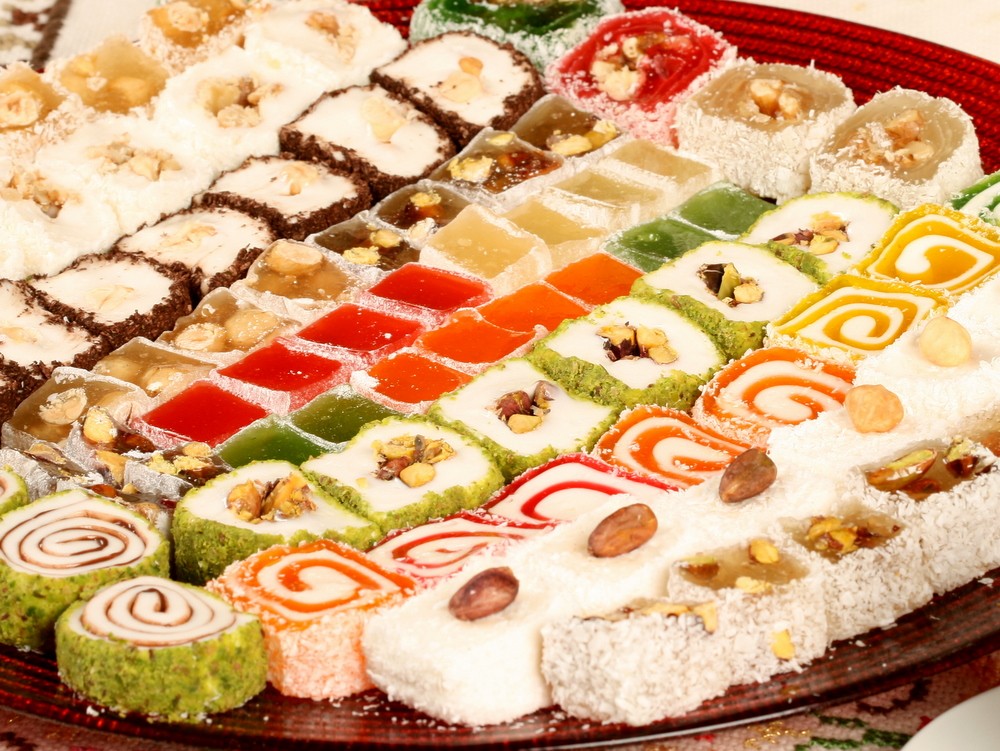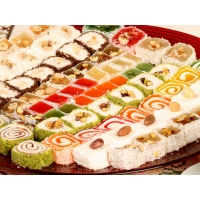Among the best Anatolian dessert and the most famous in the world is lokum, which is known in Turkish as "lokum". Although there are many myths about the beginning of the emergence of lokum, most historians agree that it originated in the Ottoman palace. Some legends say that this sweets were invented to help those who have a greedy food among the palace residents to digest, while other myths say that the Sultan asked to make a color of sweets to maintain harmony between the harem of his wives. The author of "History of Turkish Sweets" explains that lokum, as we know it today, did not exist in the seventeenth century. Its original name "Rahat Al Delkum" means freshening the throat, and it used to make dessert. Later on, its name was changed to Rahat Lokum, and finally Lokum only. For centuries Westerners have questioned the secret recipe for this dessert. Dessert consists of a few main ingredients: starch, sugar, water, and lemon juice. When sugar began to be produced, it replaced honey or grape juice. In the modern era, a simple mixture of flavors is used from fruit juice or from spices, and ingredients can be more to include nuts, saffron, cream, curd, dairy-free nougat, petal leaves (petal flowers) and puffed rice (hawashi). That is why hundreds of different types of lokum can be made to cater to all tastes, and in line with dietary restrictions and budgets. Delight sweets have been transported to all parts of the world in merchants' bags. And by the year 1861, we can see in the archives of magazines that lokum has found its way into all European cultures. In Britain, for example, it was called a "joy cut" in the nineteenth century. In the Balkans and the Middle East, this dessert was called "Luqum", and then it became known as Turkish delight in the rest of the world. To this day, European companies have not been able to obtain approval from Turkish candy experts to manufacture lokum. Although these candies can be made with various ingredients inexpensive and simple, the method of manufacturing them is laborious and requires years of experience. Experts in lokum say that the secret of its manufacture is to mix its ingredients at the same speed and patience, because mixing them very slowly or very quickly will make the mixture crystallize and become inedible. It is easier to master making lokum in the era of technology than in the eighteenth century. In any case, it is necessary to make the slices (each 15 inches long) on cold marble, and a hard table surface to add the appropriate outer layer, after which the dessert is ready to be transported around the world. And consume it within two or three weeks. If the sweetness of the lokum, which contains the nuts, is not properly preserved, it will spoil and rot. How does one distinguish good quality lokum chunks? Experts say that when touching the base of a candy bar, it should not leave a trace, and the smell of the candy bar should indicate the type of flavor used to make it. In addition, eating a bite of sweets prompts one to eat more, as in the wonderful Cliff Table Lewis children's masterpiece "The Lion and the Witch and the Wardrobe" or in the movie "Chronicles of Narina," when young Edmund sells his soul to the White Queen in exchange for a bite or two of lokum. Most Americans learned about lokum from this classic book, which made them question the taste of this mysterious dessert. And American consumers who search for lokum in local stores to taste, end up buying an unknown can, and the dessert on offer often has a bitter taste. For decades the only way to taste good quality lokum was to get it from Turkey. During the first ten months of 2015, lokum sales at Istanbul Ataturk International Airport broke the record, reaching 990 tons. More recently, companies that sell lokum have begun to sell their products in the United States. Hagi Bakir, which was founded in 1977 and is known for its impeccable products, especially roasted lokum spirit, began to receive online orders, and the famous Güloglu baklava store In Gaziantep it has branches in New York and Los Angeles. And this year the "Lockhome" store opened in San Diego and Garden Grove, California, with waves of candy lovers flocking to it. The store only sells lokum sweets. The owner of the store, Turkey Hot, told Al-Monitor that the "Lockhome" store has customers in Houston and Chicago, and work is progressing to open new branches in San Francisco and Los Angeles. Last Friday, Al-Monitor's editor visited the Lockhome store in San Diego, near Disneyland, and found Turkai Hot and his Arabic-speaking assistant cutting slices of different types of lokum. Small trays and wooden toothpicks encouraged customers to try the variety of lokum. "We started with 65 different flavors of lokum, and we offer 49 types. We are trying to explain to our customers everything about lokum, and we also explain to them how we can develop their tastes and priorities," said Hot. Turkey Hot has lokum slices shipped from Turkey every week, and their quality is judged by a number of customers on Friday morning, and it is clear that the dessert is popular and has good sales. "Turkish Airlines flights from Los Angeles to Istanbul began to introduce the spirit of lokum to passengers, which helped increase the company's sales," Turkay said. All Halqoom Soul boxes are made upon customers ’request, so that customers can choose the varieties of Lokum Soul that they want. Turkai says, "The lokum spirit provides a healthy alternative to harmful foods. If you have an allergy to nuts, then we have the lokum spirit without the nuts. Most of our products do not include any colorings, and all of our products are dairy-free, even those that contain nougat." Most varieties of lokum contain much less sugar than other sweets. A customer told Al-Monitor, “I bought lokum from here for the first time last June to surprise my 8-year-old daughter. Now I go back every week to buy it, because my daughter eats walnuts, almonds, hazelnuts and pistachios without a fuss. We now buy them as gifts for friends and family as well.” Soul lokum stores allow customers who do not know it to get acquainted with and taste it, while lovers of lokum spirit will relive their fond memories of this sweet. Store owner Turkai Hot listens carefully to his customers' comments and requests. The most skeptical of customers, however, returns to Lokhome after having tried the desserts in other stores











Validate your login
Sign In
Create New Account